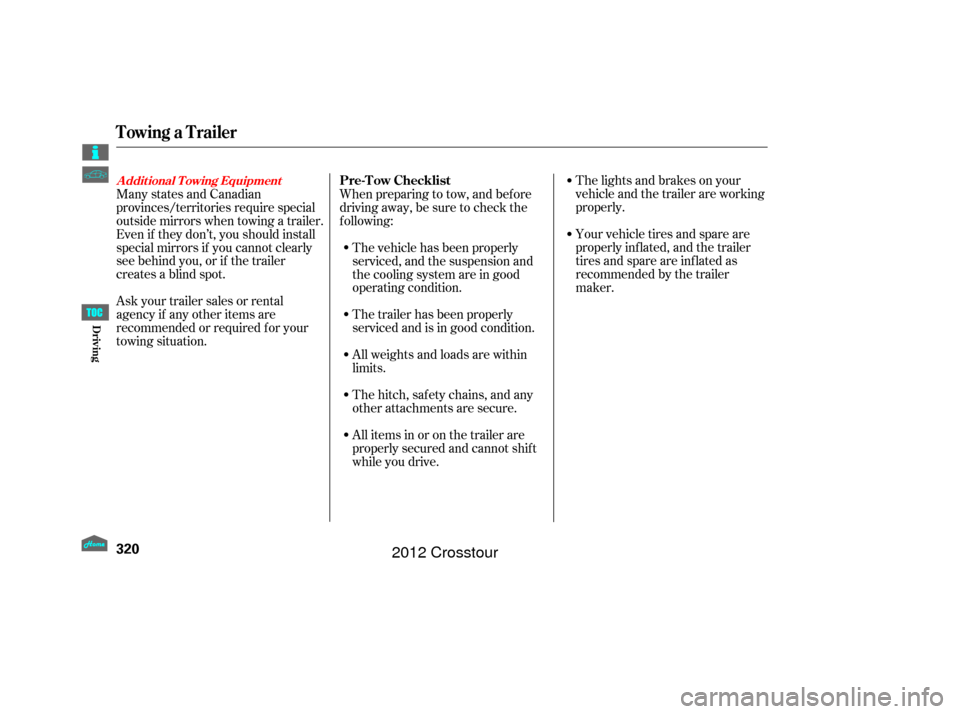Page 288 of 435
Park with the driver’s side closest
to the service station pump.
Make sure the driver’s door is
unlocked. The f uel f ill door always
locks or unlocks in conjunction
with the driver’s door.The vehicle doors and the f uel f ill
door will automatically relock if
the remote transmitter unlock
f unction is used. In this instance,
the security relock f unction can be
deactivated by brief ly opening
then closing the driver’s door.
Outside of the vehicle, push on the
right side edge of the f uel f ill door
in the middle. The f uel f ill door
will pop up slightly. Pull it outward
to open it.
1.
2. 3.
Service Station Procedures
Ref ueling
284
Pull out
Push
FUEL FILL DOOR
Gasoline is highly flammable
and explosive. You can be
burned or seriously injured
when handling fuel.
Stop the engine, and keep
heat, sparks, and flame away.
Handle fuel only outdoors.
Wipe up spills immediately.
Bef ore Driving
2012 Crosstour
Page 291 of 435
Park the vehicle, and set the
parking brake. Pull the hood
release handle located under the
lower lef t corner of the dashboard.
The hood will pop up slightly.If the hood latch handle moves stif f ly,
or if you can open the hood without
lif ting the handle, the mechanism
should be cleaned and lubricated. To close the hood, lower it to about a
f oot (30 cm) above the f ender, then
press down f irmly with your hands.
Make sure the hood is securely
latched. Lif t the hood up most of the way.
The hydraulic supports will lif t it up
therestof thewayandholditup.
Put your f ingers under the f ront
edge of the hood near the center.
Slide your hand to the lef t until
you f eel the hood latch handle.
Slide this handle to the right to
release the hood. Lif t up the hood.
1.
2.
Opening and Closing the Hood
Service Station Procedures
287
HOOD RELEASE HANDLE
LATCH
Bef ore Driving
2012 Crosstour
Page 301 of 435

Store or secure all items that could
be thrown around and hurt
someone during a crash.Be sure items placed on the f loor
behind the f ront seats cannot roll
under the seats and interf ere with
the driver’s ability to operate the
pedals, the operation of the seats,
or the operation of the sensors
under the seats.
Keep all cargo below the bottom
of the windows. If it is higher, it
could interf ere with the proper
operation of the side curtain
airbags.
Keep the glove box closed while
driving. If it is open, a passenger
could injure their knees during a
crash or sudden stop.Distribute cargo evenly on the
f loor of the cargo area, placing the
heaviest items on the bottom and
as far forward as possible. Tie
down items that could be thrown
about the vehicle during a crash or
sudden stop.
If youfolddownthebackseat,tie
down items that could be thrown
about the vehicle during a crash or
sudden stop.
If you carry large items that
prevent you f rom closing the
tailgate, exhaust gas can enter the
passenger area. To avoid the
possibility of
, f ollow the instructions
on page . 51
CONT INUED
Carrying Items in the
Passenger Compartment Carrying Cargo in the Cargo
Area or on a Roof Rack
carbon monoxide
poisoning
Carrying Cargo
297
Bef ore Driving
2012 Crosstour
Page 302 of 435
If you carry any items on a roof
rack,besurethetotalweightof
the rack and the items does not
exceed 121 lbs (55 kg).The f our hooks can be used to install
a net f or securing items. Each hook
is designed to hold up to 56.2 lbs
(25.5 kg) of weight.
The total weight of the roof rack
and the items should also be
includedinthemaximumload
limits f or your vehicle.
Cargo Hooks
Carrying Cargo
298
FLOOR CARGO HOOK
SIDE CARGO HOOK
Bef ore Driving
2012 Crosstour
Page 304 of 435
Youshoulddothefollowingchecks
and adjustments bef ore you drive
your vehicle.Make sure all windows, mirrors,
and outside lights are clean and
unobstructed. Remove f rost, snow,
or ice.
Check that the hood is f ully closed. When you start the engine, check
the gauges and indicators in the
instrument panel (see page ).
Visually check the tires. If a tire
looks low, use a gauge to check its
pressure.
Check that any items you may be
carrying are stored properly or
f astened down securely. Check the seat adjustment (see
page ).
Check the adjustment of the
inside and outside mirrors (see
pages and ).
Check the steering wheel
adjustment (see page ).
Make sure the doors and the
tailgate are securely closed and
locked.
Fasten your seat belt. Check that
your passengers have f astened
their seat belts (see page ).
3. 2. 1.
4. 5.
6.
7.
8.
9.
14 55
10.
93
104 105 76
Preparing to Drive
300
Driving
2012 Crosstour
Page 311 of 435

Always use the parking brake when
you park your vehicle. Make sure
the parking brake is set f irmly, or
your vehicle may roll if it is parked
on an incline.If the vehicle is f acing uphill, turn
the front wheels away from the
curb.
Make sure the moonroof and the
windows are closed.
Turn of f the lights.
Set the parking brake bef ore you put
the transmission in Park. This keeps
the vehicle from moving and putting
pressure on the parking mechanism
in the transmission. Place any packages, valuables, etc.,
wheretheycannotbeseenfrom
outsidethevehicleortakethem
with you.
Never park over dry leaves, tall
grass, or other f lammable
materials. The hot three way
catalytic converter could cause
these materials to catch on fire. Check the indicator on the
instrument panel to verif y that the
security system is set. Lock the doors and the tailgate.
Make sure the parking brake is
f ully released bef ore driving away.
Driving with the parking brake
partially set can overheat or
damage the rear brakes. If the vehicle is f acing downhill,
turn the front wheels toward the
curb.
Parking T ips
Parking
307
Driving
2012 Crosstour
Page 322 of 435

If you choose electric brakes, be
sure they are electronically actuated.
Do not attempt to tap into your
vehicle’s hydraulic system. No
matter how successf ul it may seem,
any attempt to attach trailer brakes
to your vehicle’s hydraulic system
will lower braking ef f ectiveness and
create a potential hazard.
Seeyourtrailerdealerorrental
agency f or more inf ormation on
installing electric brakes.
Towing can require a variety of
equipment, depending on the size of
your trailer, how it will be used, how
much load you are towing, and
where you tow.
Any hitch used on your vehicle must
be properly bolted to the underbody.
Always use saf ety chains when you
tow a trailer. Make sure the chains
are secured to the trailer and hitch,
and that they cross under the tongue
and can catch the trailer if it
becomes unhitched. Leave enough
slack to allow the trailer to turn
corners easily, but do not let the
chains drag on the ground.There are two common types of
trailer brakes: surge and electric.
Surge brakes are common f or boat
trailers, since the brakes will get wet.
Discuss your needs with your trailer
sales or rental agency, and f ollow the
guidelines in the rest of this section.
Also make sure that all equipment is
properly installed and that it meets
f ederal, state, provincial, territorial,
and local regulations.
Trailer Brakes
Hitches
Saf et y ChainsT owing Equipment and
A ccessories
Towing a Trailer
318
Driving
2012 Crosstour
Page 324 of 435

The lights and brakes on your
vehicle and the trailer are working
properly.
Your vehicle tires and spare are
properly inf lated, and the trailer
tires and spare are inflated as
recommended by the trailer
maker.
Askyourtrailersalesorrental
agency if any other items are
recommended or required f or your
towing situation. When preparing to tow, and bef ore
driving away, be sure to check the
f ollowing:
Many states and Canadian
provinces/territories require special
outside mirrors when towing a trailer.
Even if they don’t, you should install
special mirrors if you cannot clearly
see behind you, or if the trailer
creates a blind spot. The vehicle has been properly
serviced, and the suspension and
the cooling system are in good
operating condition.
The trailer has been properly
serviced and is in good condition.
All weights and loads are within
limits.
Thehitch,safetychains,andany
other attachments are secure.
All items in or on the trailer are
properly secured and cannot shif t
while you drive.
Towing a Trailer
A ddit ional T owing EquipmentPre-T ow Checklist
320
Driving
2012 Crosstour